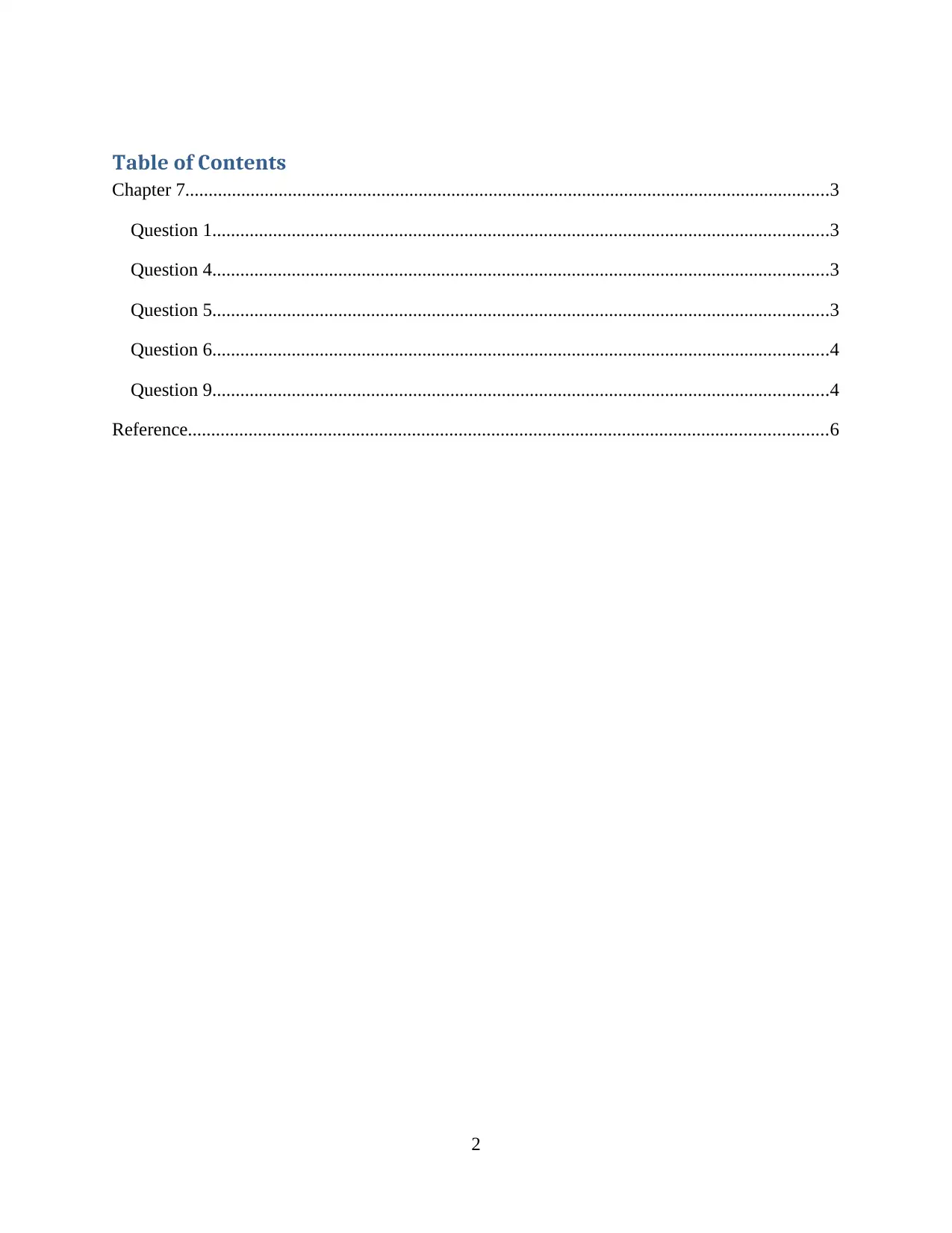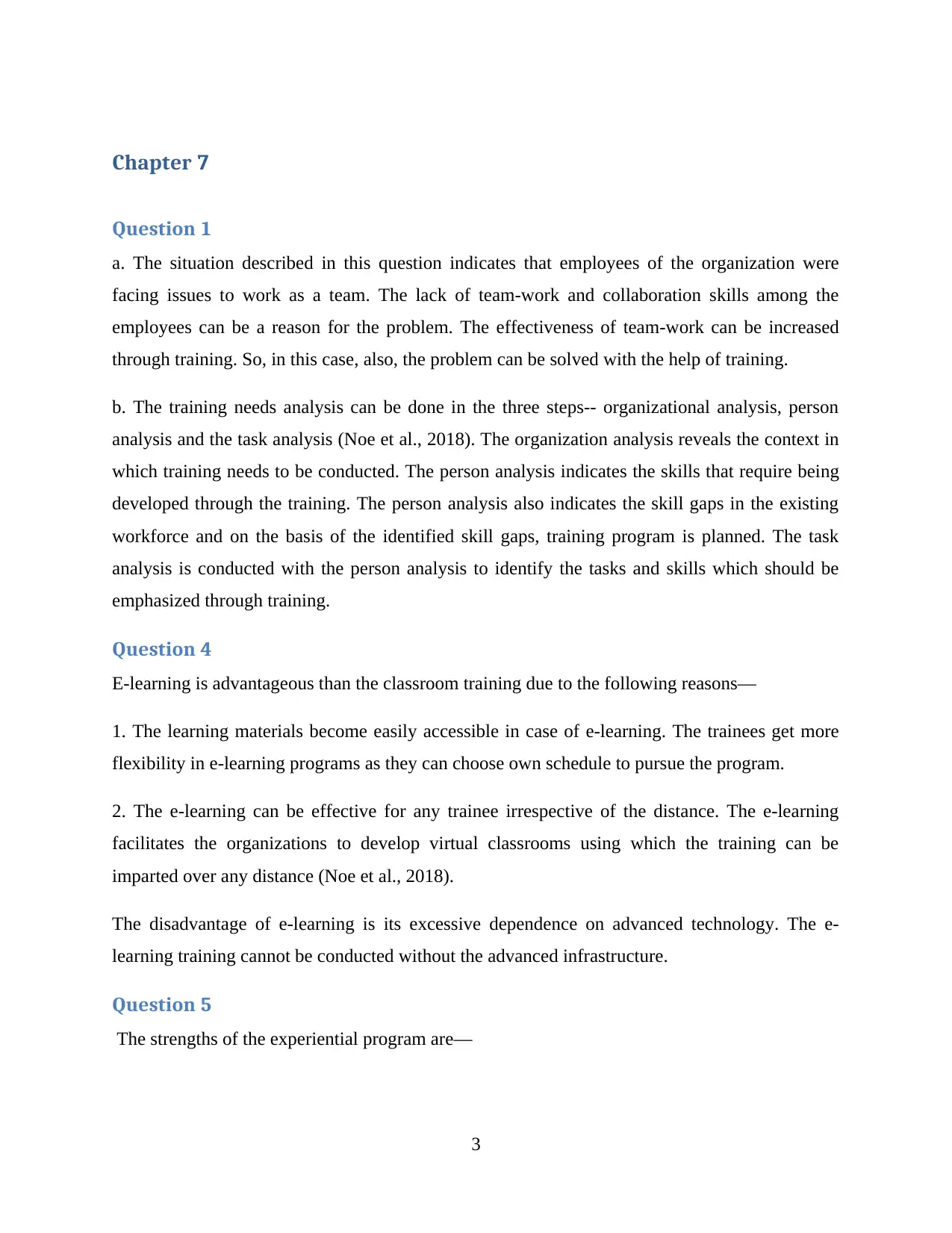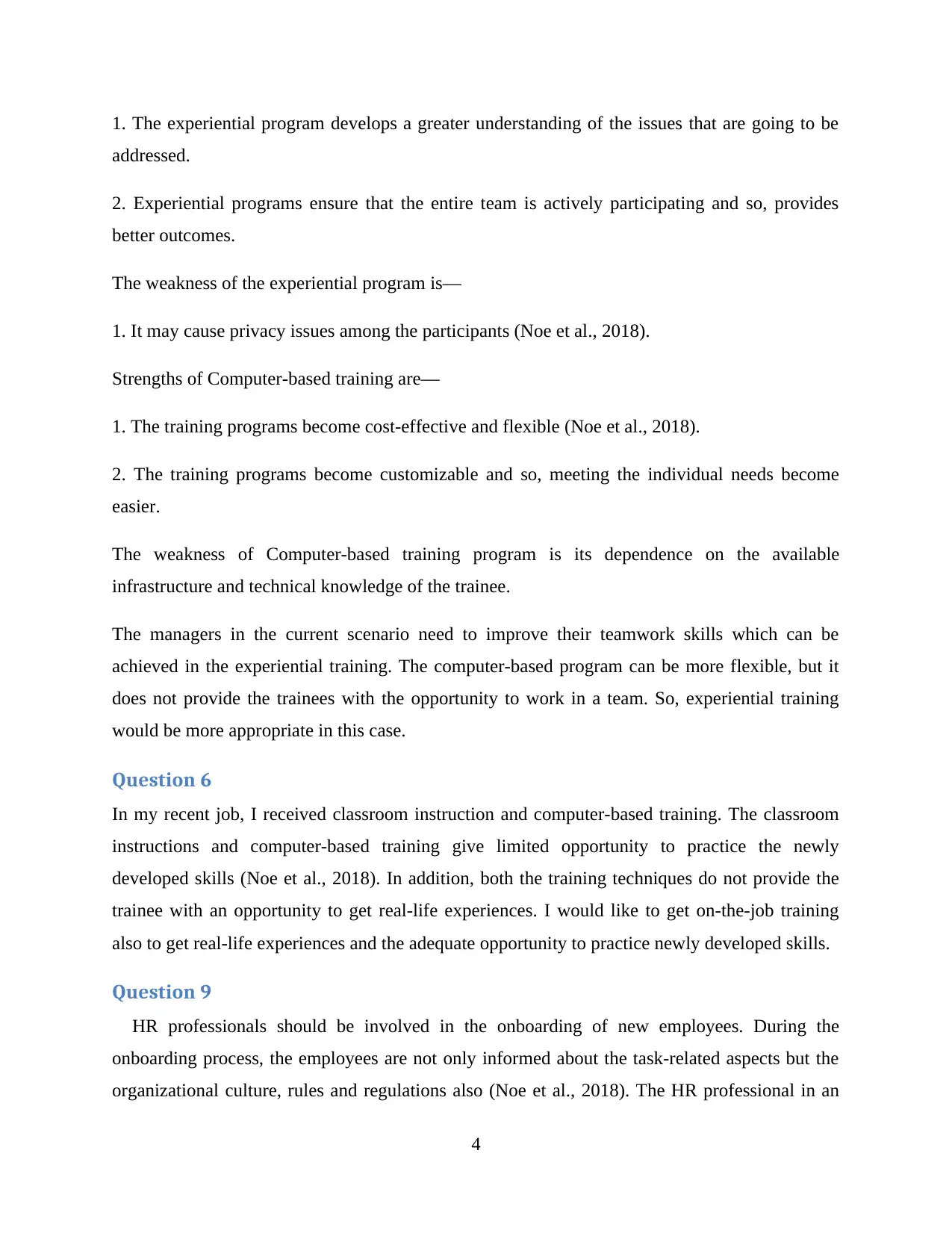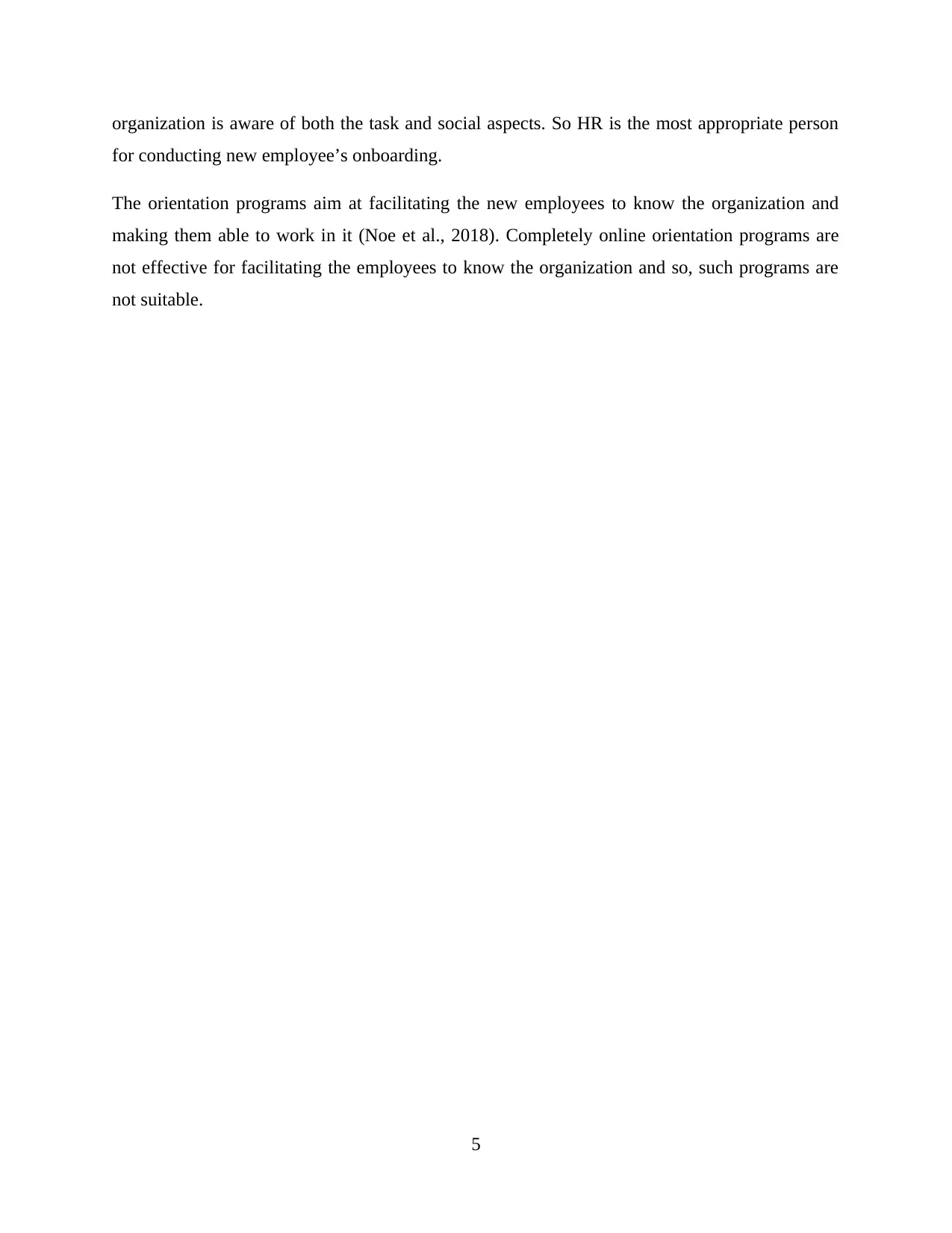Human Resource Management: Chapter 7 Assignment Solutions and Analysis
VerifiedAdded on 2019/10/08
|6
|745
|371
Homework Assignment
AI Summary
This document provides solutions to a Human Resource Management (HRM) assignment, specifically focusing on Chapter 7. The assignment addresses key concepts in HRM, including training needs analysis, e-learning versus classroom training, the strengths and weaknesses of experiential and computer-based training programs, and the importance of on-the-job training. The document also explores the role of HR professionals in employee onboarding and orientation programs. The solutions provided offer a comprehensive understanding of these HRM topics, supported by relevant references and practical examples. The assignment covers the topics of training, development, and onboarding processes within an organization, providing insights into various training methods and their effectiveness.

HUMAN RESOURCE MANAGEMENT
1
1
Paraphrase This Document
Need a fresh take? Get an instant paraphrase of this document with our AI Paraphraser

Table of Contents
Chapter 7..........................................................................................................................................3
Question 1....................................................................................................................................3
Question 4....................................................................................................................................3
Question 5....................................................................................................................................3
Question 6....................................................................................................................................4
Question 9....................................................................................................................................4
Reference.........................................................................................................................................6
2
Chapter 7..........................................................................................................................................3
Question 1....................................................................................................................................3
Question 4....................................................................................................................................3
Question 5....................................................................................................................................3
Question 6....................................................................................................................................4
Question 9....................................................................................................................................4
Reference.........................................................................................................................................6
2

Chapter 7
Question 1
a. The situation described in this question indicates that employees of the organization were
facing issues to work as a team. The lack of team-work and collaboration skills among the
employees can be a reason for the problem. The effectiveness of team-work can be increased
through training. So, in this case, also, the problem can be solved with the help of training.
b. The training needs analysis can be done in the three steps-- organizational analysis, person
analysis and the task analysis (Noe et al., 2018). The organization analysis reveals the context in
which training needs to be conducted. The person analysis indicates the skills that require being
developed through the training. The person analysis also indicates the skill gaps in the existing
workforce and on the basis of the identified skill gaps, training program is planned. The task
analysis is conducted with the person analysis to identify the tasks and skills which should be
emphasized through training.
Question 4
E-learning is advantageous than the classroom training due to the following reasons—
1. The learning materials become easily accessible in case of e-learning. The trainees get more
flexibility in e-learning programs as they can choose own schedule to pursue the program.
2. The e-learning can be effective for any trainee irrespective of the distance. The e-learning
facilitates the organizations to develop virtual classrooms using which the training can be
imparted over any distance (Noe et al., 2018).
The disadvantage of e-learning is its excessive dependence on advanced technology. The e-
learning training cannot be conducted without the advanced infrastructure.
Question 5
The strengths of the experiential program are—
3
Question 1
a. The situation described in this question indicates that employees of the organization were
facing issues to work as a team. The lack of team-work and collaboration skills among the
employees can be a reason for the problem. The effectiveness of team-work can be increased
through training. So, in this case, also, the problem can be solved with the help of training.
b. The training needs analysis can be done in the three steps-- organizational analysis, person
analysis and the task analysis (Noe et al., 2018). The organization analysis reveals the context in
which training needs to be conducted. The person analysis indicates the skills that require being
developed through the training. The person analysis also indicates the skill gaps in the existing
workforce and on the basis of the identified skill gaps, training program is planned. The task
analysis is conducted with the person analysis to identify the tasks and skills which should be
emphasized through training.
Question 4
E-learning is advantageous than the classroom training due to the following reasons—
1. The learning materials become easily accessible in case of e-learning. The trainees get more
flexibility in e-learning programs as they can choose own schedule to pursue the program.
2. The e-learning can be effective for any trainee irrespective of the distance. The e-learning
facilitates the organizations to develop virtual classrooms using which the training can be
imparted over any distance (Noe et al., 2018).
The disadvantage of e-learning is its excessive dependence on advanced technology. The e-
learning training cannot be conducted without the advanced infrastructure.
Question 5
The strengths of the experiential program are—
3
⊘ This is a preview!⊘
Do you want full access?
Subscribe today to unlock all pages.

Trusted by 1+ million students worldwide

1. The experiential program develops a greater understanding of the issues that are going to be
addressed.
2. Experiential programs ensure that the entire team is actively participating and so, provides
better outcomes.
The weakness of the experiential program is—
1. It may cause privacy issues among the participants (Noe et al., 2018).
Strengths of Computer-based training are—
1. The training programs become cost-effective and flexible (Noe et al., 2018).
2. The training programs become customizable and so, meeting the individual needs become
easier.
The weakness of Computer-based training program is its dependence on the available
infrastructure and technical knowledge of the trainee.
The managers in the current scenario need to improve their teamwork skills which can be
achieved in the experiential training. The computer-based program can be more flexible, but it
does not provide the trainees with the opportunity to work in a team. So, experiential training
would be more appropriate in this case.
Question 6
In my recent job, I received classroom instruction and computer-based training. The classroom
instructions and computer-based training give limited opportunity to practice the newly
developed skills (Noe et al., 2018). In addition, both the training techniques do not provide the
trainee with an opportunity to get real-life experiences. I would like to get on-the-job training
also to get real-life experiences and the adequate opportunity to practice newly developed skills.
Question 9
HR professionals should be involved in the onboarding of new employees. During the
onboarding process, the employees are not only informed about the task-related aspects but the
organizational culture, rules and regulations also (Noe et al., 2018). The HR professional in an
4
addressed.
2. Experiential programs ensure that the entire team is actively participating and so, provides
better outcomes.
The weakness of the experiential program is—
1. It may cause privacy issues among the participants (Noe et al., 2018).
Strengths of Computer-based training are—
1. The training programs become cost-effective and flexible (Noe et al., 2018).
2. The training programs become customizable and so, meeting the individual needs become
easier.
The weakness of Computer-based training program is its dependence on the available
infrastructure and technical knowledge of the trainee.
The managers in the current scenario need to improve their teamwork skills which can be
achieved in the experiential training. The computer-based program can be more flexible, but it
does not provide the trainees with the opportunity to work in a team. So, experiential training
would be more appropriate in this case.
Question 6
In my recent job, I received classroom instruction and computer-based training. The classroom
instructions and computer-based training give limited opportunity to practice the newly
developed skills (Noe et al., 2018). In addition, both the training techniques do not provide the
trainee with an opportunity to get real-life experiences. I would like to get on-the-job training
also to get real-life experiences and the adequate opportunity to practice newly developed skills.
Question 9
HR professionals should be involved in the onboarding of new employees. During the
onboarding process, the employees are not only informed about the task-related aspects but the
organizational culture, rules and regulations also (Noe et al., 2018). The HR professional in an
4
Paraphrase This Document
Need a fresh take? Get an instant paraphrase of this document with our AI Paraphraser

organization is aware of both the task and social aspects. So HR is the most appropriate person
for conducting new employee’s onboarding.
The orientation programs aim at facilitating the new employees to know the organization and
making them able to work in it (Noe et al., 2018). Completely online orientation programs are
not effective for facilitating the employees to know the organization and so, such programs are
not suitable.
5
for conducting new employee’s onboarding.
The orientation programs aim at facilitating the new employees to know the organization and
making them able to work in it (Noe et al., 2018). Completely online orientation programs are
not effective for facilitating the employees to know the organization and so, such programs are
not suitable.
5

Reference
Noe, R., Hollenbeck, J., Gerhart, B., & Wright, P. (2018). Fundamentals of Human Resource
Management
6
Noe, R., Hollenbeck, J., Gerhart, B., & Wright, P. (2018). Fundamentals of Human Resource
Management
6
⊘ This is a preview!⊘
Do you want full access?
Subscribe today to unlock all pages.

Trusted by 1+ million students worldwide
1 out of 6
Related Documents
Your All-in-One AI-Powered Toolkit for Academic Success.
+13062052269
info@desklib.com
Available 24*7 on WhatsApp / Email
![[object Object]](/_next/static/media/star-bottom.7253800d.svg)
Unlock your academic potential
Copyright © 2020–2025 A2Z Services. All Rights Reserved. Developed and managed by ZUCOL.





